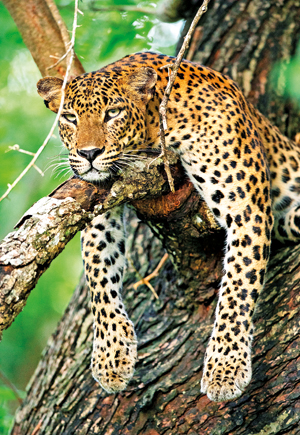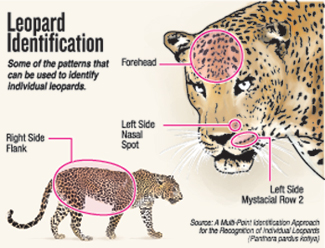Spot on!

A lazy moment: YF 19 Emma. Pic by Prasad Sendanayake
Leopards do change their spots. They also change their rosettes!
Putting paid to a much-used saying about these magnificent Big Cats, is a study at the Yala National Park done by a group of leopard lovers in coordination with the Department of Wildlife Conservation (DWC).
The shape and form of spots and rosettes change, this Sri Lankan team has documented, proven and established. This occurs due to injuries leopards suffer in the wild.
This unique study, titled ‘A Multi-Point Identification Approach for the Recognition of Individual Leopards (Panthera pardus kotiya)’ has just been published in ‘Animals’, a scholarly, peer-reviewed scientific journal of MDPI, based in Basel, Switzerland. It had been accepted on March 3 which was World Wildlife Day and published last Sunday (March 6).
A main author Dushyantha Silva says that earlier there was an assumption that the shape and form of the spots and rosettes of leopards remain constant. This could have resulted in misidentification of leopards, as when the spot-and-rosette pattern varied, it may have been assumed that it was a different leopard.
Arriving at their findings after peering closely at photos and comparing and contrasting images, the study states that using visual identifications through the capture-recapture method could result in inaccuracies. They had observed 29 instances of changes to spot-and-rosette formations in leopards at Yala National Park, Block 1.
“Therefore, to address this issue, we developed the multi-point leopard identification method, which is a ‘novel process’ of identification,” says Dushyantha.
They have thus established as at March 31, 2021 (last year), that the minimum leopard population of Yala National Park, Block 1 was at least 77, while identifying 137 individual leopards since 2013 using this method. The population density, meanwhile, is 0.5461 leopards per sq.km.
The method used by the group has segregated a leopard’s coat to 15 points according to the spot-and-rosette formations of those areas, for more accurate identification.
 “We suggest that a minimum of nine of the 15 ‘multi-point reference code’ should be compared thoroughly with existing images, before classifying a leopard as a newly-identified animal,” says Dushyantha, stressing that whenever leopards suffered injuries, they had noticed a change in the pattern before and after the injury, with some of the spots and rosettes diminishing or even getting erased.
“We suggest that a minimum of nine of the 15 ‘multi-point reference code’ should be compared thoroughly with existing images, before classifying a leopard as a newly-identified animal,” says Dushyantha, stressing that whenever leopards suffered injuries, they had noticed a change in the pattern before and after the injury, with some of the spots and rosettes diminishing or even getting erased.
The main authors of the study are Milinda Wattegedera, Dushyantha Silva, Mevan Piyasena and Raveendra Siriwardena, while the co-authors are Chandana Sooriyabandara, Prasantha Wimaladasa, Ranjan M.S.L.R.P. Marasinghe, Bhagya M. Hathurusinghe, Rajapakse M.R. Nilanthi, Sadeepa Gunawardena, Heshan Peiris, Pasan Seneviratne, Pramod C. Sendanayake, Chathura Dushmantha, Sudantha Chandrasena, Sahan S. Gooneratne, Pumudi Premaratne, Sandaru Wickremaratne and Mindaka Mahela.
The researchers are from the Leopard Research and Data Gathering Team, Yala Leopard Visitor Centre and the Department of Wildlife Conservation.
(The study may be accessed on: https://www.mdpi.com/2076-2615/12/5/660/pdf)
| Feisty females and interactions: Spotlight on behaviour | |
| Unique and different seem to be the behaviour of the sleek beauties of the Yala National Park that wildlife enthusiast Dushyantha Silva and his friends have uncovered.“We have seen the unique phenomenon of a mother and son mating,” says Dushyantha, going onto explain that there are code-names and a system (a continuous running number) of naming leopards, while of course they have their own nicknames for these Big Cats. He explains that it runs thus………YM10 (which means Yala Male 10) or YF10 (Yala Female 10), with a similar diary record and system now taking place at close-by Kumana National Park. However, whoever spots a leopard for the first time gets the honour of giving it a nickname and handsome ‘Lucas’ is a well-photographed favourite, while ‘Strawberry’ is another. Dushyantha does not have a favourite but likes newer leopards and one rarely seen is ‘Lanka’. All this has come about from a leopard identification project initiated by Milinda Wattegedara in 2013 with the other team members being Dushyantha, Raveendra Siriwardena, Mevan Piyasena, Heshan Peiris, Sadeepa Gunawardena, Pramod Sendanayake, Pasan Seneviratne, Chathura Dushmantha, Sahan Gooneratne, Dr. Sudantha Chandrasena, Mindaka Mahela, Pumudi Premaratne and Sandaru Wickremaratne. Other extraordinary behaviour, the group has recorded at Yala, includes “all sorts of interactions” among the leopards even though they are usually believed to be solitary creatures. The Yala leopards share the same home range with such sharing between sub-adult males with older males; aged females with younger females; and same-age females. The home-range of both males and females also expands, with some born in one area going to another, it has been found. The female beauties of Yala are quite feisty too – according to literature the male is usually the Romeo going out with several partners but here at Yala, the females rendezvous with multiple partners at the same time sharing the home range, says Dushyantha. Another phenomenon is communal feeding – they have seen seven leopards from three families feeding on one deer carcass. There had also been an instance of two leopards feeding together, he says, pointing out that “we have based our earlier ideas on experiences reported from Africa. However, at least at Yala it seems to be different”. Big Cat behaviour in Africa could be different as the apex predator (a species at the top of the food chain with no natural predators within its ecosystem) is the lion. Therefore, the lion is above the leopard there, but here the apex predator is the leopard, while there is also no food or water shortage for leopards at Yala. This would cut out the competition. The leopard identification initiative led to the creation of a bank of photographs and videos from which blossomed the ‘Yala Leopard Diary’. By 2018, they shared their work with the DWC and with the work speaking for itself, the Assistant Director of Uva, Prasantha Wimaladasa and Yala Park Warden Pradeep Siyasinghe and Deputy Warden Ranjith Sisira Kumara who were also keen watchers of leopards exchanged data with them. Hot on the pug-prints of this interaction followed a request for the publication of an official Leopard Guide Book for the DWC, which they did, all the while sharing the identification of leopards with the DWC’s Head Office including Director-General Chandana Sooriyabandara and park staff in 2019. From all this work then arose the idea of establishing an Information Centre on Leopards at Yala, as there was no such centre anywhere in the world. Roping in Navesta Pharmaceuticals and E-wis as sponsors who linked up with the DWC, the Dr. Ravi Samarasinha Memorial Building at Palatupana had been renovated and an LED screen provided giving out information on all the leopards which had been identified along with their family trees. Large panels are also on display on special leopard behaviour that the group has seen. “Using the Memorial Building is a fitting tribute to Dr. Samarasinha who dedicated his life for leopard study,” says Dushyantha. From identifying leopards, the group had moved onto studying their behaviour in 2019 with the DWC’s Research and Training Department. It was in 2021 that software engineers in their group came up with a software for anyone who clicks photos of leopards and uploads them to get an automatic ‘match’ or ‘identification’. It is about 95% accurate, says Dushyantha, going onto explain that it is free of charge. While some findings of the group have been published in ‘WILDLANKA’, the journal of the DWC, more are in the pipeline. (The diary may be accessed on: |
Searching for an ideal partner? Find your soul mate on Hitad.lk, Sri Lanka's favourite marriage proposals page. With Hitad.lk matrimonial advertisements you have access to thousands of ads from potential suitors who are looking for someone just like you.


